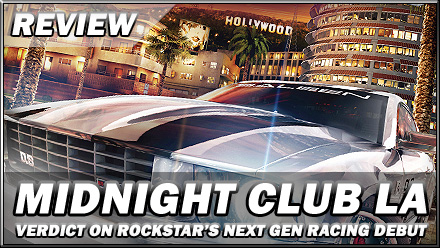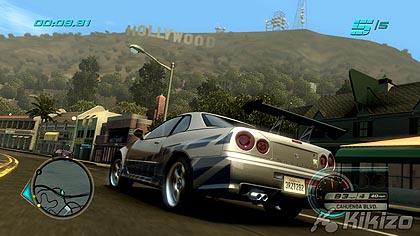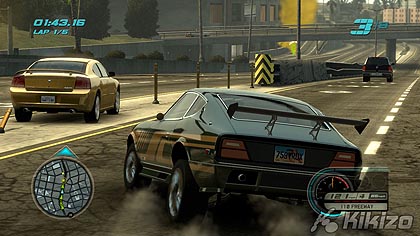Midnight Club Los Angeles
Here's our definitive verdict on Rockstar's entry into the next-generation Midnight Club series, beginning in LA.
| Version Xbox 360, (PS3) | Developer Rockstar San Diego | Publisher Rpckstar | Genre Racing |
||||

Page: 1 2
By Adam Doree
We first saw Midnight Club Los Angeles over a year ago, and we've been excited about it ever since. Whenever gamers have debated about the upcoming Need for Speeds versus the Burnouts versus the Gothams of this non-simulation racing genre, far too often have we found ourselves puzzled that MCLA was getting overlooked in the discussion. We hope it now finally gets the attention it deserves, because the final game lives up to the obvious potential we saw in it last year - and we think it's going to catch many gamers by surprise if they have the common sense to give it a go.
Rockstar San Diego has come up with a completely new take on the Midnight Club series - so much so that we think they should have named it something else entirely to make the point. The strong sales of the series on last gen consoles may explain why they've kept the same brand, but the point we want to make is that whether you knew or cared for the series before, now is the time sit up and pay attention to it.
Stylish and classy presentation is in evidence throughout, from the slick intro sequence to the lack of any clunky front end with no loading screens - one of the many leafs developed right out of the GTA IV book. (And there's no install on the PS3 version, either). The story and cut scenes are nicely done, and while not up to the standard of Rockstar North's next-gen endeavour, I don't think anybody expected it to be - but what it does in that department, it does pretty well, with a bunch of characters who while unsurprisingly one dimensional, are decently voiced, with some dialogue even bordering on amusing. Some competing racers don't even have a cast of human characters, so no complaints, really.
There's a fantastic level of destructibility in MCLA, including entire buildings - you can literally smash your way inside the Santa Monica Mall and cause all kinds of havoc inside where people are trying to shop - and perhaps make an exit from the top of the building. The Mall is one of many recognisable landmarks throughout the game - and while some have their names changed (Sports Center rather than Staples, Exhibition Hall rather than Convention Center) many things are correctly branded, including hotels like The Standard. However, all landmarks are visually faithful to the real thing, which is what matters - and no matter what part of the vast Los Angeles map you're driving in, each place really looks and feels like the real life equivalent - you can almost smell the thick Downtown air and the restaurants of West Hollywood. Smashing through the environments at high speed is really fun, whether you're on the streets, in a parking lot, or sneakily cutting through private property.
While all the action in the game boils down to racing, it's no bad thing. Firstly, because the core racing engine and tight controls ensure a racing game that's playable from the word go; steering your car around feels beautifully tuned and it's really a pleasure to race or roam, with the emphasis on subtlety of controls and keeping your cool - rarely do we find ourselves needing to use the brake, and even the handbrake is used sparingly. Instead the average bend can be negotiated with thoughtful release of the gas and some wheel tricks. There's a fantastic sense of speed throughout, which while not as insane as in Burnout, basically makes Niko Bellic look like a grandmother in a Reliant Robin. Importantly, it's easy to see where you are supposed to be going in races that have a set route, because your map radar in the bottom left always indicates two waypoints ahead, allowing you to plan out the way you're going to architect your next few corners on the fly rather then be caught out by an unexpected upcoming turn, while the most imminent waypoint is also marked on the street itself with a brightly coloured flare.
The other reason why MCLA's racing formula doesn't get old is that things are kept interesting thanks to a great level of variety in the races you'll take part in, forming a sizable overall single player game of around 40 hours, in our estimation. It's not like you need to memorise the huge map early on in order to win races; many are the kind flagged with waypoints, but there's a good balance with race types where you just hit the ground running when you see an opponent, or where you just choose your own route to the other side of the city - these are the races where experience with the map and your vehicle will get ahead in the core game. Many of the races that come your way will also allow you to choose the terms - where to race, whether or not it'll be circuit based, and also time of day. And a final key layer to mix things up is opponent difficulty, with four colour coded levels of harshness.
Of course, you've got your old friend the power up to help you against the opposition. At first, you'll need to buy your nitrous tanks manually by earning money, but once you've got a couple equipped, the action starts to pick up. In addition to your nitrous boost though, you can also turbo boost during races by drafting behind an opponent at high speed, and when the time is right an audio cue will let tell you you're ready to let rip - but you have to use it within a couple of seconds, so getting your positioning and timing right is important. In no time, this proves a natural mechanic to the racing that is a good risk-reward balance and is fun to pull off. If you manage to keep your cool all the way to the finish line, it's very satisfying, particularly when you've taken a lot of damage and one false move could result in your car being wiped out from the race altogether (or worse, a series of races you'd invested some time into).
The game gradually opens out as well with new features and types of challenge, with one early introduction being police. Outrunning them once you're on their (quite over sensitive) radar works in pretty much the same way as in GTA IV, with the difficulty of outrunning them comparable to about the three star level in Liberty City. You earn some rep for outrunning them, but sometimes you'd just rather get on with your next mission rather than outrun them if you've proved it's something you're already competent at. The game's scalable and non-linear difficulty, approachable progress structure and forgiving learning curve mean that it should appeal to a broad audience without impossible races to beat. Even when you do get punished in a particularly hard race (and an error will often be very difficult to come back from), the game's structure ensures that the emphasis stays on fun.
Page: 1 2











 Satoru Iwata Video Interview - the late Nintendo president spoke with Kikizo in 2004 as 'Nintendo Revolution' loomed.
Satoru Iwata Video Interview - the late Nintendo president spoke with Kikizo in 2004 as 'Nintendo Revolution' loomed. Kaz Hirai Video Interview - the first of Kikizo's interviews with the man who went on to become global head of Sony.
Kaz Hirai Video Interview - the first of Kikizo's interviews with the man who went on to become global head of Sony. Ed Fries Video Interview - one of Xbox's founders discusses an epic journey from Excel to Xbox.
Ed Fries Video Interview - one of Xbox's founders discusses an epic journey from Excel to Xbox. Yu Suzuki, the Kikizo Interview - we spend time with one of gaming's most revered creators.
Yu Suzuki, the Kikizo Interview - we spend time with one of gaming's most revered creators. Tetris - The Making of an Icon: Alexey Pajitnov and Henk Rogers reveal the fascinating story behind Tetris
Tetris - The Making of an Icon: Alexey Pajitnov and Henk Rogers reveal the fascinating story behind Tetris Rare founders, Chris and Tim Stamper - their only interview? Genuinely 'rare' sit down with founders of the legendary studio.
Rare founders, Chris and Tim Stamper - their only interview? Genuinely 'rare' sit down with founders of the legendary studio. The History of First-Person Shooters - a retrospective, from Maze War to Modern Warfare
The History of First-Person Shooters - a retrospective, from Maze War to Modern Warfare